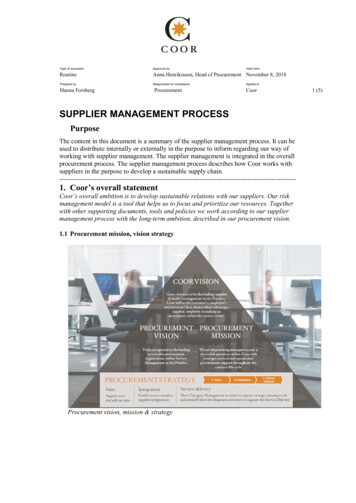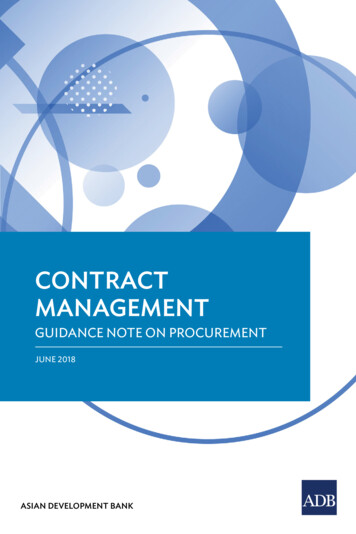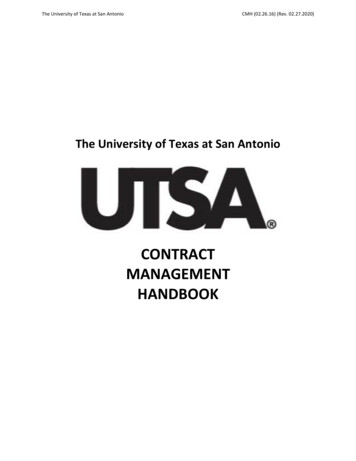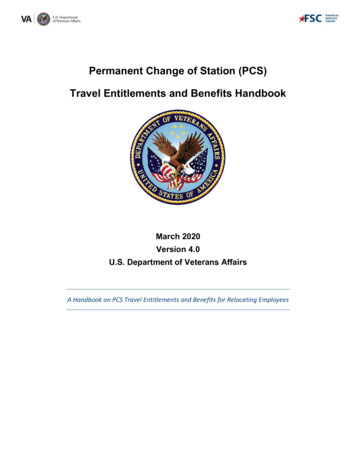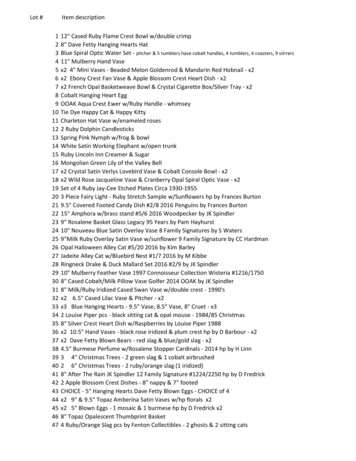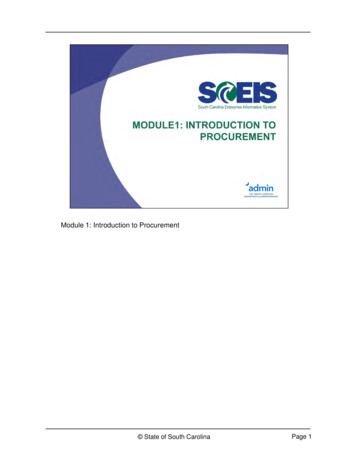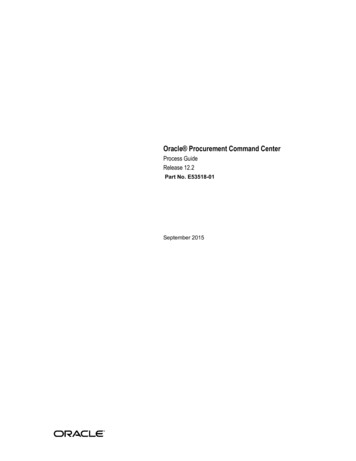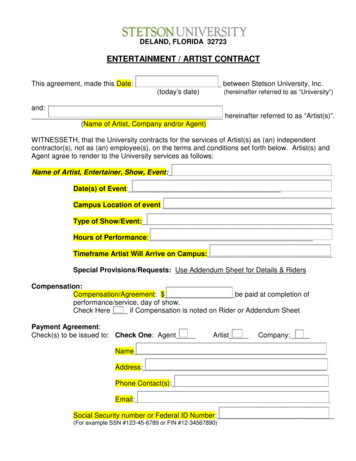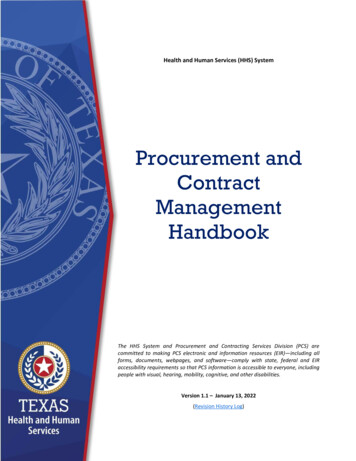
Transcription
Health and Human Services (HHS) SystemProcurement andContractManagementHandbookThe HHS System and Procurement and Contracting Services Division (PCS) arecommitted to making PCS electronic and information resources (EIR)—including allforms, documents, webpages, and software—comply with state, federal and EIRaccessibility requirements so that PCS information is accessible to everyone, includingpeople with visual, hearing, mobility, cognitive, and other disabilities.Version 1.1 – January 13, 2022(Revision History Log)
Procurement and Contract Management Handbook, v. 1.1PrefaceWithin the past decade, Texas has experienced a significant increase in population. This increase has led to moreservices being needed to meet the challenges of the expanding population, which in turn has led to the Health andHuman Services Commission (HHSC) engaging in more procurements and contracting opportunities. So, it follows,that proper procedures, policies, and guidelines must be in place to provide efficiency and proper oversight to theprocurement and contracting process, while simultaneously protecting the taxpayer’s dollar; therefore, it isimperative that the HHSC Procurement and Contracting Services division (PCS) create a handbook to address variousissues in the procurement and contracting process.This HHS Procurement and Contract Management Handbook (Handbook) is designed to be a dynamic document;one that will evolve with legislative changes, best practices, and with feedback from program areas. As you read theHandbook and you find that minor changes need to be made, for example, typographical errors, please emailPCS DEC@hhsc.state.tx.us with those suggested changes. Minor, non-substantive changes will be made to theHandbook upon receipt.If any division wants PCS to consider an amendment to any provision of the Handbook, such recommendationsshould be submitted to PCS at PCS DEC@hhsc.state.tx.us. All recommendations will be considered; however, thefinal content of the Handbook is subject to the approval of the Deputy Executive Commissioner of PCS and/or theChief Operating Officer or HHS Executive Commissioner, if escalation is necessary.Further, in considering substantive amendments and/or recommendations to the Handbook that could affectprocess and/or procedural changes to HHS divisions other than PCS, PCS will seek stakeholder input prior toapproving and implementing such amendments and will provide messaging of proposed changes throughout theprocess and at resolution, allowing sufficient time to plan for such change. More specifically, when substantiveamendments and/or recommendations are submitted, within one week of receiving the proposed change, amember of PCS will contact the person who submitted the recommended change to gather more information. If,based on the information gathered, PCS determines that the proposed amendment or recommendation wouldbenefit the Handbook, a member of the PCS team will arrange a meeting with identified stakeholders to review theproposed amendment or recommendation and review a draft of the proposed change. The identified stakeholderswill then provide written feedback on the proposed change. The PCS member assigned to the change will review thewritten feedback and incorporate what is necessary to achieve the goal of the proposed recommendation. Ifnecessary and pending the complexity and outcome of the proposed changes, PCS will also complete any researchnecessary with third-party agencies, consult with the Compliance and Quality Control division, the Office of ChiefCounsel, HHS executive management, and complete any other due diligence necessary to support therecommendation. Thereafter, PCS will meet with the stakeholders one more time to ensure that the proposedchange accurately reflects the goal and intended purpose of the amendment or recommendation. Once theamendment or recommendation is approved by the stakeholders, the amendment/recommendation will besubmitted to the Deputy Executive Commissioner of PCS and/or the Chief Operating Officer or HHS ExecutiveCommissioner for final approval. Once approved and properly messaged, the changes will be made to the Handbookand documented on the Revision History Log.PCS will complete a review of the entire Handbook biennially to reflect substantive amendments not previouslymade and to conform with laws enacted by the Texas State Legislature. It is the goal of PCS to make appropriatechanges to the Handbook in a timely fashion so that the Handbook remains useful and relevant. Any questionsconcerning the Handbook should be sent to PCS DEC@hhsc.state.tx.us.i
Procurement and Contract Management Handbook, v. 1.1TABLE OF CONTENTSTABLE OF CONTENTS . iiGeneral Information . 71.Purpose.71.1The Three Lines of Defense Model Relating to Risk .71.2Standards and Authority .81.3Applicability .92.Introduction .92.1Procurement and Contracting Authority .102.2Ethics and Professional Standards .112.3Nondisclosure, Conflict of Interest, Nepotism Certification .133.Vendor Communications .154.Required Training .164.1Certified Texas Contract Developer (CTCD) .164.2Certified Texas Contract Manager (CTCM) .164.3Licensed Attorney .174.4Continuing Education and Certification Renewal .174.5Required Cybersecurity Training for HHS and Contracted Staff .175.Procurement and Contracting Services Division (PCS) .175.1PCS Procurement Teams .185.2PCS Stakeholder Partners .246.Overview of HHS Agency Roles and Responsibilities .266.1Customer Organizations Roles .276.2PCS Roles.276.3CQC Roles .276.4PCS Operating Model .286.5Management Pillars of Operations .29Procurement Planning . 307.Planning and Development .317.1Procurement Lead Times .317.2Needs Assessment .327.3Factors for Assessing Need .327.4Risk Management .337.5Contract Value Estimate .33ii
Procurement and Contract Management Handbook, v. 1.17.6Request for Information (RFI) .347.7Procurement Planning Results and Outputs .357.8Procurement Forecast and Action Plan (PFAP) .357.9The Statement of Work (SOW) .367.10Contractor Compensation .417.11Determination of Payment Type .417.12Selection Methodology—Evaluation Team Selection & Scoring .427.13Evaluation Criteria .477.14Direct Contract Award Method .567.15Historically Underutilized Business (HUB) Determination .577.16Determination of Subrecipient, Recipient, or Contractor Relationship .597.17Planning Exception—Emergency Procurements .607.18The Requisition .60Procurement Methods: Solicitations and Grants . 678.Procurement Methods .688.1Texas Disaster Act of 1975 .688.2State and Federal Surplus Property Program .698.3Texas Correctional Industries (TCI) Purchases .698.4State Use Program .708.5CPA Statewide Contracts .718.6Spot Purchases (Non-DIR) .739.Competitive Procurement .749.1Informal Bidding (Non-DIR).759.2Formal Bidding (Non-DIR) .759.3Work Order Process .759.4Information Technology Purchases .769.5Printing Services.809.6Conference and Meeting Room Space .829.7Emergency Procurements .839.8Proprietary Purchases .849.9Consulting Services Contracts .859.10Request for Proposal (RFP) .889.11RFP Construction .899.12Request for Qualifications (RFQ) .899.13Drafting the Solicitation .90iii
Procurement and Contract Management Handbook, v. 1.19.14Specification Drafting.909.15Entering a Requisition for an RFx or IFB Procurement .9210.Non-Competitive Contracts, Agreements, and Open Enrollments .9210.1Non-Competitive Contracts and Agreements .9210.2Open Enrollment Contracts .9411.Grants .9611.1Request for Applications (RFA) .9711.2Determination of Subrecipient, Recipient, or Contractor Relationship Process .9811.3Non-Competitive Direct Grant Award .10112.Solicitation Review .10112.1System Contracting .10112.2Compliance and Quality Control Review (CQC) .10212.3Contract Advisory Team (CAT) Review .10212.4Quality Assurance Team (QAT) Review — Major Information Resources Projects (MIRP) .10212.5CQC Review of Solicitations and Evaluations .10412.6Solicitation Advertisement .10412.7Vendor Conference .105Vendor Selection . 10613.Vendor Selection .10713.1Bid Room.10713.2Screening Responses — Bids, Proposals, and Applications .10713.3Litigation History Review .11113.4Financial Capacity Review .11213.5Reference Checks .11213.6Notice of Disqualification and Intent to Award (aka Tentative Award Procedure) .112Contract Formation and Award. 11314.Contract Formation and Award .11414.1Contract Negotiations .11414.2Purchase Orders and Contracts .11514.3Procurement Card (State Issued Credit Card) .11614.4Contract Terms .11614.5Insurance .11914.6Bonds .11914.7Prevailing Wage Rates .12314.8Uniform General Conditions for Construction .123iv
Procurement and Contract Management Handbook, v. 1.114.9Grant Awards .12414.10Coordination and Preparation of Contract Documents .12514.11Certification Regarding Lobbying .12814.12Required Screening for Potential Contractors .12814.13Disclosure of Interested Parties .13014.14Contract Award .13114.15Vendor Debriefing.13614.16Bid Protests .136Contract Management . 13715.Contract Management .13815.1System of Contract Operation and Reporting (SCOR) .13815.2Contract Manager Responsibilities .13815.3Contractor Training and Technical Assistance .13915.4Contract Oversight .14015.5Oversight of Grant Performance.14115.6Contract Risk Assessment .14215.7Contract Monitoring Plan .14415.8Contract Monitoring .14415.9Contractor and Grantee Screening Post-Award Checks .14515.10Contract Monitoring Activities .14515.11Assessing Internal Controls .15015.12HSP Monitoring and Progress Assessment Report (PAR) .15115.13Monitoring DUA Compliance .15115.14Monitoring of Staff Augmentation Contractors.15115.15Contract Monitoring Documentation and Follow-Up Activities .15215.16Enhanced Contract and Performance Monitoring .15315.17Financial Management of Contracts .15415.18Review for Amendment, Renewal or Re-procurement .15515.19Contract Amendments, Bridge Extensions and Renewals .15515.20Contractor Performance Issues and Contract Remedies .15915.21Escalation of Contract Issues .16016.Contract Expiration, Termination, Closeout, and Settlement .16116.1Contract Expiration .16116.2Contract Termination.16116.3Contract Closeout .163v
Procurement and Contract Management Handbook, v. 1.116.4Grant Closeout .16416.5Contract Settlement .16416.6Provide Contractor with Settlement .16517.Contract Records .16617.1System of Contract Operation and Reporting (SCOR) .16617.2Contract File Checklists .16617.3Disclosure or Audit of Contract Records .16717.4Records Retention .16717.5Absent Contract Records Requirements .16718.Required Reporting .17018.1Vendor Performance Reporting .17018.2Federal Funding Accountability and Transparency Act of 2006 (FFATA) Reporting .17118.3WorkQuest Exception Reporting — Monthly Report on Set Aside Exceptions .17218.4Reporting HHS Contracts .17319.Version History of the Handbook .17919.1Revision History Log .179Appendices .180vi
Procurement and Contract Management Handbook, v. 1.1General Information1.PURPOSEThe purpose of the Procurement and Contract Management Handbook (Handbook) is to establish consistentprocurement and contract management policies and procedures that must be followed by the Health and HumanServices (HHS) System agencies: the Health and Human Services Commission (HHSC)1 and the Department of StateHealth Services (DSHS).2 Additionally, HHSC provides procurement services to the Department of Family andProtective Services (DFPS)3 and the Texas Civil Commitment Office (TCCO).4 The Handbook aligns with the vision andgoverning principals defined in the Health and Human Services Procurement and Contracting System Strategic Planfor Fiscal Years 2020-2023.Additionally, this Handbook includes best practices to provide guidance for solicitations and managing HHScontracts.1.1The Three Lines of Defense Model Relating to RiskEach HHS agency shall have an internal structure to identify and mitigate procurement and contracting risksthat align with the Three Lines of Defense Model (TLDM). TLDM is designed to provide clarity and coordinationto specific roles and responsibilities for risk management.HHS agency Executive Management and the Procurement and Contracting Improvement Plan ExecutiveSteering Committee are responsible for setting objectives to manage risks and defining strategies to achievethem, as well as establishing governance structures and processes. Under the TLDM, staff will shareinformation and coordinate efforts across related customer organizations.1.1.1First Line of DefenseThe first line of defense is the day-to-day ownership of identifying risks and developing,implementing, and managing controls and risk management processes. These include, but are notlimited to:1.1.2a.Procurement Planning: Program, HHS Procurement and Contracting Services (PCS);b.Procurement Processing: Program, PCS;c.Evaluation: HHS Compliance and Quality Control (CQC), Program, PCS;d.Negotiation: Program, PCS;e.Contract Formation: Program, PCS;f.Contract Management: Program, Contract Manager; andg.Contract Close-out/Termination: Program, Contract Manager.Second Line of DefenseThe second line of defense is to facilitate and monitor the implementation of effective riskmanagement practices and to ensure they are operating as intended. It also provides for aTex. Gov’t Code § 2155.144(j), (l).Tex. Gov’t Code §§ 531.001(4)(B), 2155.144(p).3 Tex. Hum. Res. Code § 40.058(i).4 Tex. Gov’t Code § 420A.011.127
Procurement and Contract Management Handbook, v. 1.1compliance function to monitor risks associated with applicable policies, procedures, regulations,and statutes. The second line of defense includes the following, grouped by
This HHS Procurement and Contract Management Handbook (Handbook) is designed to be a dynamic document; one that will evolve with legislative changes, best practices, and with feedback from program areas. As you read the Handbook and you find that minor changes need to
